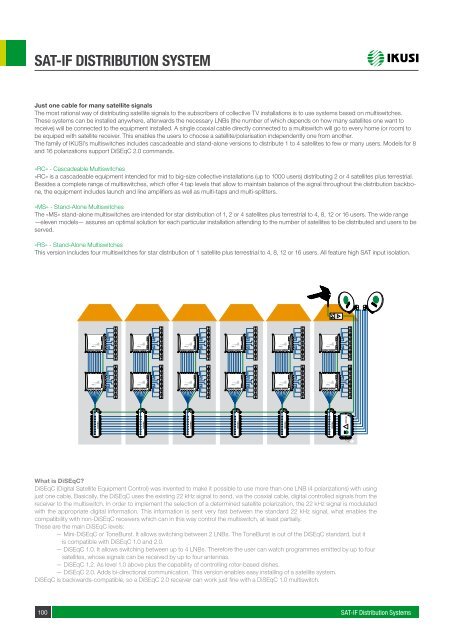general catalog - Index of
general catalog - Index of
general catalog - Index of
Create successful ePaper yourself
Turn your PDF publications into a flip-book with our unique Google optimized e-Paper software.
SAT-IF DISTRIBUTION SYSTEMJust one cable for many satellite signalsThe most rational way <strong>of</strong> distributing satellite signals to the subscribers <strong>of</strong> collective TV installations is to use systems based on multiswitches.These systems can be installed anywhere, afterwards the necessary LNBs (the number <strong>of</strong> which depends on how many satellites one want toreceive) wiil be connected to the equipment installed. A single coaxial cable directly connected to a multiswitch will go to every home (or room) tobe equiped with satellite receiver. This enables the users to choose a satellite/polarisation independently one from another.The family <strong>of</strong> IKUSI’s multiswitches includes cascadeable and stand-alone versions to distribute 1 to 4 satellites to few or many users. Models for 8and 16 polarizations support DiSEqC 2.0 commands.«RC» - Cascadeable Multiswitches«RC» is a cascadeable equipment intended for mid to big-size collective installations (up to 1000 users) distributing 2 or 4 satellites plus terrestrial.Besides a complete range <strong>of</strong> multiswitches, which <strong>of</strong>fer 4 tap levels that allow to maintain balance <strong>of</strong> the signal throughout the distribution backbone,the equipment includes launch and line amplifiers as well as multi-taps and multi-splitters.«MS» - Stand-Alone MultiswitchesThe «MS» stand-alone multiswitches are intended for star distribution <strong>of</strong> 1, 2 or 4 satellites plus terrestrial to 4, 8, 12 or 16 users. The wide range—eleven models— assures an optimal solution for each particular installation attending to the number <strong>of</strong> satellites to be distributed and users to beserved.«RS» - Stand-Alone MultiswitchesThis version includes four multiswitches for star distribution <strong>of</strong> 1 satellite plus terrestrial to 4, 8, 12 or 16 users. All feature high SAT input isolation. What is DiSEqC?DiSEqC (Digital Satellite Equipment Control) was invented to make it possible to use more than one LNB (4 polarizations) with usingjust one cable. Basically, the DiSEqC uses the existing 22 kHz signal to send, via the coaxial cable, digital controlled signals from thereceiver to the multiswitch. In order to implement the selection <strong>of</strong> a determined satellite polarization, the 22 kHz signal is modulatedwith the appropriate digital information. This information is sent very fast between the standard 22 kHz signal, what enables thecompatibility with non-DiSEqC receivers which can in this way control the multiswitch, at least partially.These are the main DiSEqC levels:— Mini-DiSEqC or ToneBurst. It allows switching between 2 LNBs. The ToneBurst is out <strong>of</strong> the DiSEqC standard, but itis compatible with DiSEqC 1.0 and 2.0.— DiSEqC 1.0. It allows switching between up to 4 LNBs. Therefore the user can watch programmes emitted by up to foursatellites, whose signals can be received by up to four antennas.— DiSEqC 1.2. As level 1.0 above plus the capability <strong>of</strong> controlling rotor-based dishes.— DiSEqC 2.0. Adds bi-directional communication. This version enables easy installing <strong>of</strong> a satellite system.DiSEqC is backwards-compatible, so a DiSEqC 2.0 receiver can work just fine with a DiSEqC 1.0 multiswitch.100SAT-IF Distribution Systems



